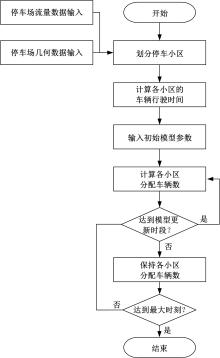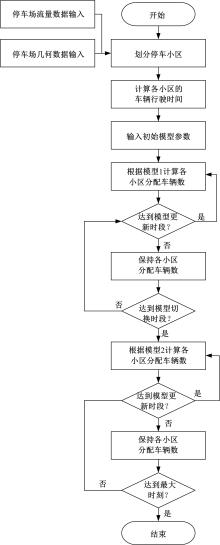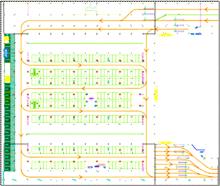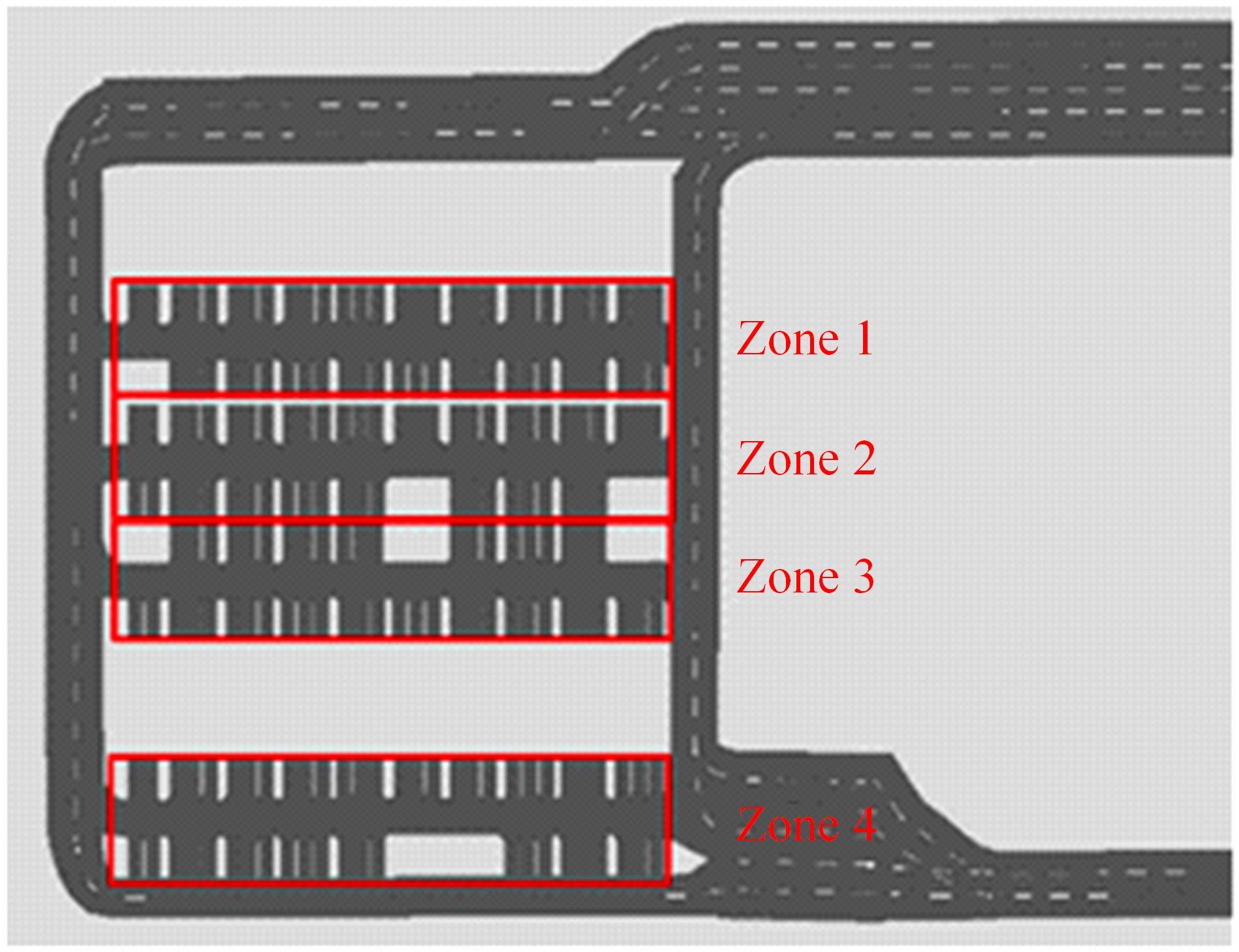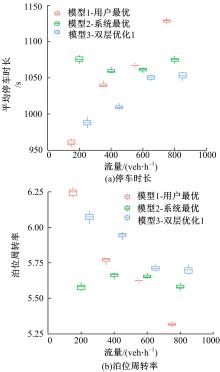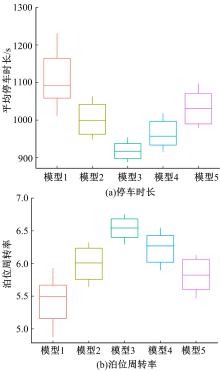吉林大学学报(工学版) ›› 2022, Vol. 52 ›› Issue (6): 1344-1352.doi: 10.13229/j.cnki.jdxbgxb20210093
• 交通运输工程·土木工程 • 上一篇
基于用户-系统双层优化算法的车位引导模型
- 1.同济大学 道路与交通工程教育部重点实验室,上海 201804
2.上海市交通发展研究中心,上海 200030
Parking guidance model based on user and system bi⁃level optimization algorithm
Song-xue GAI1,2( ),Xiao-qing ZENG1(
),Xiao-qing ZENG1( ),Xiao-yuan YUE1,Zi-hao YUAN1
),Xiao-yuan YUE1,Zi-hao YUAN1
- 1.Key Laboratory of Road and Traffic Engineering of the Ministry of Education,Tongji University,Shanghai 201804,China
2.Shanghai Transport Research Center,Shanghai 200030,China
摘要:
针对当前大型停车场的车位引导系统派位随机、控制策略不清晰、系统利用率低等技术难点,基于用户最优策略建立了用户最优模型,基于系统最优策略建立了系统最优模型,找寻出两种策略分别适应不同时段的特征规律,建立了新型双层优化模型。通过仿真实验验证了本文优化模型具有更好的流量适应性、更短的停车时长和最大的泊位周转率(6.53),本文研究成果可应用于交通枢纽大型停车场控制系统。
中图分类号:
- U491.7
| 1 | Kotb A O, Shen Y C, Huang Y. Smart parking guidance, monitoring and reservations: a review[J]. IEEE Intelligent Transportation Systems Magazine, 2017, 9(2): 6-16. |
| 2 | Ata K I, Azura C S, Ishak A J, et al. Smart indoor parking system based on Dijkstra's algorithm[J]. International Journal of Electrical Engineering and Applied Sciences, 2019, 2(1): 13-20. |
| 3 | 张玉杰, 田硕. Dijkstra优化算法在停车场车位引导系统中的应用[J]. 计算机测量与控制, 2014, 22(1): 191-193. |
| Zhang Yu-jie, Tian Shuo. Dijkstra optimization algorithm used in parking lots guidance system[J]. Computer Measurement & Control, 2014, 22(1): 191-193. | |
| 4 | 王靖. 停车诱导系统中动态路径诱导技术的研究与应用[D]. 苏州: 苏州大学计算机科学与技术学院, 2008. |
| Wang Jing. Research and application of dynamic route guidance technology for PGS [D]. Suzhou: School of Computer Science and Technology, Soochow University, 2008. | |
| 5 | 许增昭, 许伦辉. Dijkstra改进算法在泊位诱导系统中的应用与仿真[J]. 科学技术与工程, 2009, 9(23): 7226-7229. |
| Xu Zeng-zhao, Xu Lun-hui. Application and simulation of developed dijkstra algorithm in the guidance of parking space[J]. Science Technology and Engineering, 2009, 9(23): 7226-7229. | |
| 6 | 王树西, 吴政学. 改进的Dijkstra最短路径算法及其应用研究[J]. 计算机科学, 2012, 39(5): 223-228. |
| Wang Shu-xi, Wu Zheng-xue. Improved Dijkstra shortest path algorithm and its application[J]. Computer Science, 2012, 39(5): 223-228. | |
| 7 | 杨嘉华. 基于双向最短路径的大型停车场停车路径优化算法[J]. 信息技术与信息化, 2016, 40(9): 58-60. |
| Yang Jia-hua. Parking path optimization algorithm of large parking lot based on bidirectional shortest path[J]. Information Technology and Informatization, 2016, 40(9): 58-60. | |
| 8 | Yuan L, Huang R, Han L, et al. A parking guidance algorithm based on time-optimal dynamic sorting for underground parking[C]∥2018 26th International Conference on Geoinformatics, Kunming, China, 2018:1-6. |
| 9 | 程丽平, 谭永海. 改进的分层A*算法在停车场路径寻优中的应用[J]. 计算机测量与控制, 2015, 23(1): 183-186. |
| Cheng Li-ping, Tan Yong-hai. Application of improved hierarchial A* algorithm for optimal parking path planning[J]. Computer Measurement and Control, 2015, 23(1): 183-186. | |
| 10 | Cheng L, Liu C, Yan B. Improved hierarchical A-star algorithm for optimal parking path planning of the large parking lot[C]∥2014 IEEE International Conference on Information and Automation (ICIA), Hailar, China, 2014: 695-698. |
| 11 | 陈群. 城市停车诱导系统设计的理论与方法研究[D]. 上海: 同济大学交通运输工程学院, 2006. |
| Chen Qun. Research on theory and method of urban parking guidance system design[D]. Shanghai: College of Transportation Engineering, Tongji University, 2006. | |
| 12 | 董洁雯. 粒子群算法在大型停车场车位诱导中的研究与应用[D]. 长春: 吉林大学计算机科学与技术学院, 2013. |
| Dong Jie-wen. Research and application of particle swarm optimization algorithm using in parking space inducing on large parking lot[D]. Changchun: College of Computer Science and Technology, Jilin University, 2013. | |
| 13 | An S, Han B, Wang J. Study of the mode of real-time and dynamic parking guidance and information systems based on fuzzy clustering analysis[C]∥Proceeding of 3rd International Conference on Machine Learning & Cybernetics, Shanghai, China, 2004: 2790-2794. |
| 14 | 季彦婕, 王炜, 邓卫. 停车场内部泊车行为特性分析及最优泊位选择模型[J]. 南京: 东南大学学报: 自然科学版, 2009, 39(2):399-403. |
| Ji Yan-jie, Wang Wei, Deng Wei. Micro-level parking behaviors within parking facilities and optimal parking space choice model[J]. Nanjing: Journal of Southeast University(Natural Science Edition), 2009, 39(2): 399-403. | |
| 15 | Geng Y, Cassandras C G. New "smart parking" system based on resource allocation and reservations[J]. IEEE Transactions on Intelligent Transportation Systems, 2013, 14(3): 1129-1139. |
| 16 | Mouskos K C, Tvantzis J, Bernstein D, et al. Mathematical formulation of a deterministic parking reservation system (PRS) with fixed costs[C]∥2000 10th Mediterranean Electrotechnical Conference, Lemesos, Cyprus, 2000: 648-651. |
| 17 | Yang Jun, Li Xing-yi, Liu Shi-hao. A reservation strategy model of finite berth based on active parking guidance and information system[C]∥2009 International Workshop on Intelligent Systems and Applications (ISA 2009), Wuhan, China, 2009:1-4. |
| 18 | Kotb A O, Shen Y C, Zhu X, et al. iParker—a new smart car-parking system based on dynamic resource allocation and pricing[J]. IEEE Transactions on Intelligent Transportation Systems, 2016, 17(9): 2637-2647. |
| 19 | 宗芳, 张屹山, 王占中, 等. 城市中心商业区停车收费分析[J]. 吉林大学学报:工学版, 2013, 43(5): 1235-1240. |
| Zong Fang, Zhang Yi-shan, Wang Zhan-zhong, et al. Parking pricing analysis in urban central business district[J]. Journal of Jilin University (Engineering and Technology Edition), 2013, 43(5): 1235-1240. | |
| 20 | PTV. Vissim 10 user manual[Z]. German: Planung Transport Verkeher AG, 2017. |
| [1] | 吴文静,战勇斌,杨丽丽,陈润超. 考虑安全间距的合流区可变限速协调控制方法[J]. 吉林大学学报(工学版), 2022, 52(6): 1315-1323. |
| [2] | 徐洪峰,陈虹瑾,张栋,陆千惠,安娜,耿现彩. 面向网联汽车环境的单点全感应式信号配时技术[J]. 吉林大学学报(工学版), 2022, 52(6): 1324-1336. |
| [3] | 尹超英,邵春福,黄兆国,王晓全,王晟由. 基于梯度提升决策树的多尺度建成环境对小汽车拥有的影响[J]. 吉林大学学报(工学版), 2022, 52(3): 572-577. |
| [4] | 贾洪飞,邵子函,杨丽丽. 终点不确定条件下网约车合乘匹配模型及算法[J]. 吉林大学学报(工学版), 2022, 52(3): 564-571. |
| [5] | 冯天军,孙学路,黄家盛,田秀娟,宋现敏. 基于三种过街方式的两相位信号交叉口延误[J]. 吉林大学学报(工学版), 2022, 52(3): 550-556. |
| [6] | 李兴华,冯飞宇,成诚,王洧,唐鹏程. 网约拼车服务选择偏好分析及建模[J]. 吉林大学学报(工学版), 2022, 52(3): 578-584. |
| [7] | 李先通,全威,王华,孙鹏程,安鹏进,满永兴. 基于时空特征深度学习模型的路径行程时间预测[J]. 吉林大学学报(工学版), 2022, 52(3): 557-563. |
| [8] | 薛锋,何传磊,黄倩,罗建. 多式轨道交通网络的耦合协调度[J]. 吉林大学学报(工学版), 2021, 51(6): 2040-2050. |
| [9] | 贾彦峰,曲大义,林璐,姚荣涵,马晓龙. 基于运行轨迹的网联混合车流速度协调控制[J]. 吉林大学学报(工学版), 2021, 51(6): 2051-2060. |
| [10] | 陆文琦,周天,谷远利,芮一康,冉斌. 基于张量分解理论的车道级交通流数据修复算法[J]. 吉林大学学报(工学版), 2021, 51(5): 1708-1715. |
| [11] | 卢凯,吴蔚,林观荣,田鑫,徐建闽. 基于KNN回归的客运枢纽聚集人数组合预测方法[J]. 吉林大学学报(工学版), 2021, 51(4): 1241-1250. |
| [12] | 彭博,张媛媛,王玉婷,唐聚,谢济铭. 基于自动编码机-分类器的视频交通状态自动识别[J]. 吉林大学学报(工学版), 2021, 51(3): 886-892. |
| [13] | 张健,吴坤润,杨敏,冉斌. 智能网联环境下交叉口双环自适应控制模型[J]. 吉林大学学报(工学版), 2021, 51(2): 541-548. |
| [14] | 王殿海,沈辛夷,罗小芹,金盛. 车均延误最小情况下的相位差优化方法[J]. 吉林大学学报(工学版), 2021, 51(2): 511-523. |
| [15] | 宋现敏,张明业,李振建,王鑫,张亚南. 动态公交专用道的设置及其仿真分析评价[J]. 吉林大学学报(工学版), 2020, 50(5): 1677-1686. |
|
||
